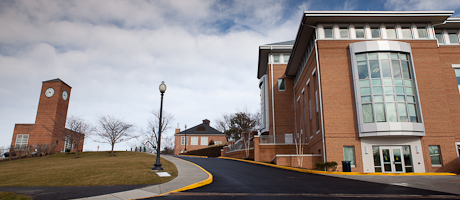GW’s Ames Hall, located on the Mount Vernon Campus, recently became the fifth George Washington University campus building to receive Leadership in Energy and Environmental Design (LEED) Gold certification.
The other Gold-certified GW buildings are the Charles E. Smith Center, Lafayette Hall, West Hall and South Hall. The Smith Center and Lafayette and South Halls are all on the Foggy Bottom Campus, while West Hall is located on the Mount Vernon Campus.
Ames Hall underwent a major renovation in 2010 and 2011 to transform the building from a residence hall and campus-life center into its current use as an academic facility. The renovated building includes a number of “green” features that helped contribute to its achievement of LEED Gold certification, said Nancy Giammatteo, GW’s director for facilities planning and design.
These features include a green roof; water bottle filling stations in the corridors; 32 bike parking spaces and four fuel-efficient vehicle preferred parking spaces; and low-volatile organic compound (VOC) paints, sealants and carpets throughout the building.
Ames Hall now also demonstrates a 39 percent decrease in potable water usage (from the baseline standard for commercial buildings), as well as a 28 percent increase in energy performance over the American Society of Heating, Refrigerating and Air-Conditioning Engineers (ASHRAE) standard for commercial buildings.
Ms. Giammatteo said she was thrilled to see another GW building achieve LEED Gold-level certification.
“We’ve had amazing success through attention to energy efficiency, water conservation and industry best practices, exceeding our goal of Silver-level certification in all five of our LEED projects to date,” she said.
Meghan Chapple-Brown, director of GW’s Office of Sustainability, highlighted the collaborative effort that made Ames Hall’s Gold certification possible.
“I'd like to commend the design and construction team on this project, as well as the Division of Operations for their continued efforts to reduce GW's electricity and water consumption,” Ms. Chapple-Brown said. “I hope that GW students will find their experience in Ames speaks to their future, and that of the planet.”


